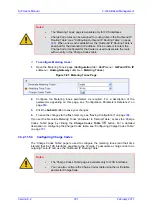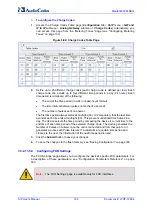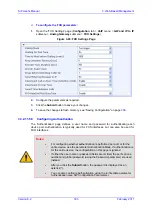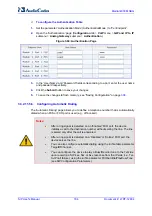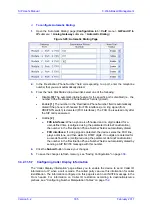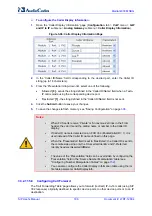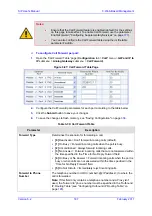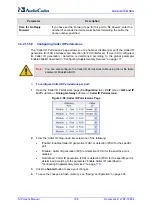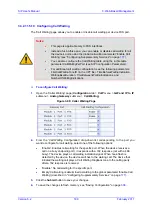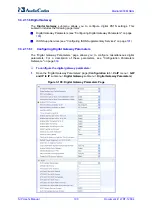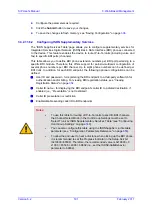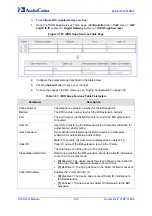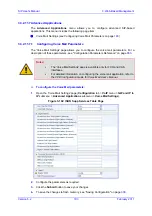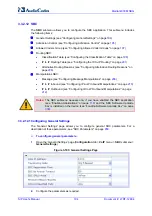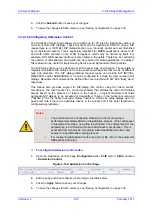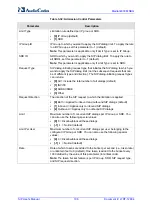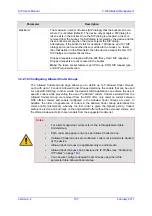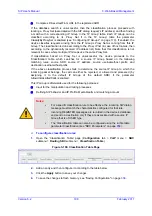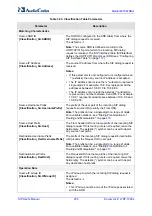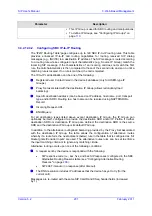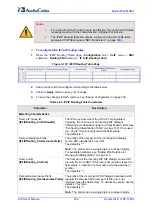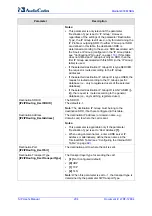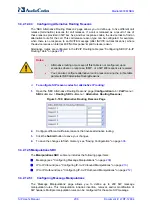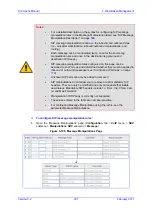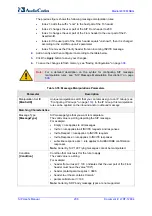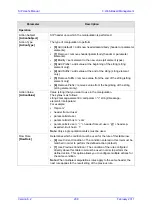
Version 6.2
195
February 2011
SIP User's Manual
3. Web-Based Management
3.
Click the
Submit
button to save your changes.
4.
To save the changes to flash memory, see ''Saving Configuration'' on page
3.3.2.12.2 Configuring Admission Control
The 'Admission Control' page allows you to define up to 100 rules for limiting the number of
concurrent calls (SIP dialogs). These call limits can be applied per SRD, IP Group, SIP
request type (e.g., INVITEs), SIP dialog direction (e.g., inbound), and/or per user (identified
by its registered contact). This is especially important for MSBG applications where VoIP
and Data traffic contend on the WAN throughput, which may be limited by itself. For
example, DSL WAN access interface is very limited in the uplink. Therefore, by controlling
the number of calls allowed, bandwidth can be reserved for Data applications. In addition,
this feature can be useful for implementing Service Level Agreements (SLA) policies.
The SIP dialog limits can be defined per SIP request type and direction. These relate to
requests that initiate SIP dialogs and not the subsequent requests that can be of different
type and direction. The SIP dialog-initiating request types can include SIP INVITEs,
REGISTER, and/or SUBSCRIBE, or it can be configured to include the total number of all
dialogs. Requests that supersede the defined limit are rejected with SIP 486 "Busy Here"
responses.
This feature also provides support for SIP-dialog rate control, using the “token bucket”
mechanism. The token bucket is a control mechanism that dictates the rate of SIP-dialog
setups based on the presence of tokens in the bucket – a logical container that holds
aggregate SIP dialogs to be accepted or transmitted. Tokens in the bucket are removed
("cashed in") for the ability to setup a dialog. Therefore, a flow can setup dialogs up to its
peak burst rate if there are adequate tokens in the bucket and if the burst threshold is
configured appropriately.
Notes:
•
The enforcement of a configured limitation for the incoming leg is
performed immediately after the Classification process. If the call/request
is rejected at this stage, no routing is performed. The enforcement for the
outgoing leg is performed within each alternative route iteration. This is
accessed from two places: one during initial classification/routing, and
another during alternative routing process.
•
For configuring Admission Control using the
ini
file, refer to the parameter
SBCAdmissionControl.
¾
To configure Admission Control rules:
1.
Open the 'Admission Control' page (
Configuration
tab >
VoIP
menu >
SBC
submenu
>
Admission Control
).
Figure
3-104: Admission Control Page
2.
Add an entry and then configure it according to the table below.
3.
Click the
Apply
button to save your changes.
4.
To save the changes to flash memory, see ''Saving Configuration'' on page
Summary of Contents for Mediant 800 MSBG
Page 2: ......
Page 366: ...SIP User s Manual 366 Document LTRT 12804 Mediant 800 MSBG Reader s Notes ...
Page 372: ...SIP User s Manual 372 Document LTRT 12804 Mediant 800 MSBG Reader s Notes ...
Page 390: ...SIP User s Manual 390 Document LTRT 12804 Mediant 800 MSBG Reader s Notes ...
Page 404: ...SIP User s Manual 404 Document LTRT 12804 Mediant 800 MSBG Reader s Notes ...
Page 616: ...SIP User s Manual 616 Document LTRT 12804 Mediant 800 MSBG Reader s Notes ...
Page 636: ...SIP User s Manual 636 Document LTRT 12804 Mediant 800 MSBG Reader s Notes ...
Page 652: ...SIP User s Manual 652 Document LTRT 12804 Mediant 800 MSBG Reader s Notes ...
Page 886: ...SIP User s Manual 886 Document LTRT 12804 Mediant 800 MSBG Reader s Notes ...

